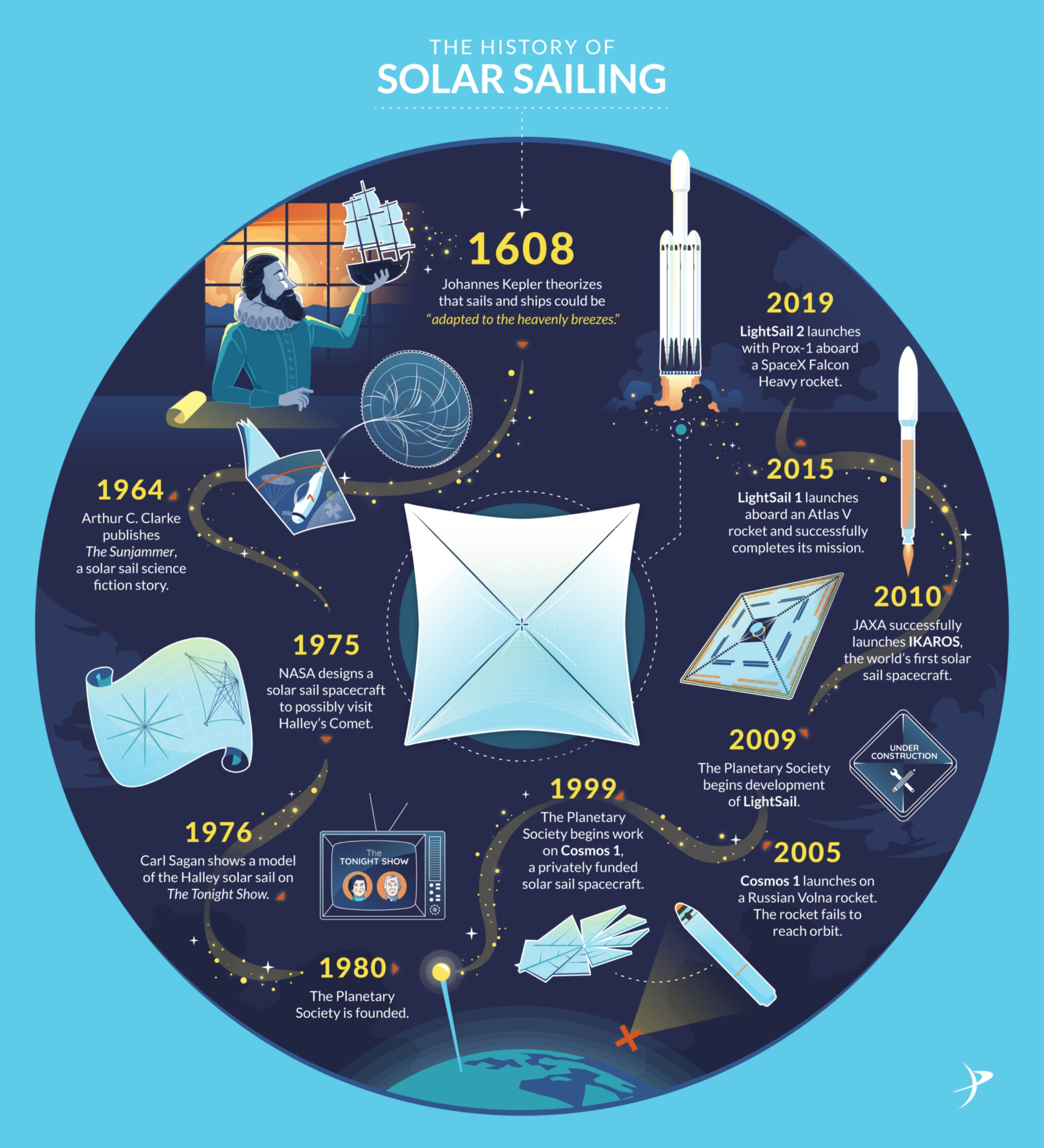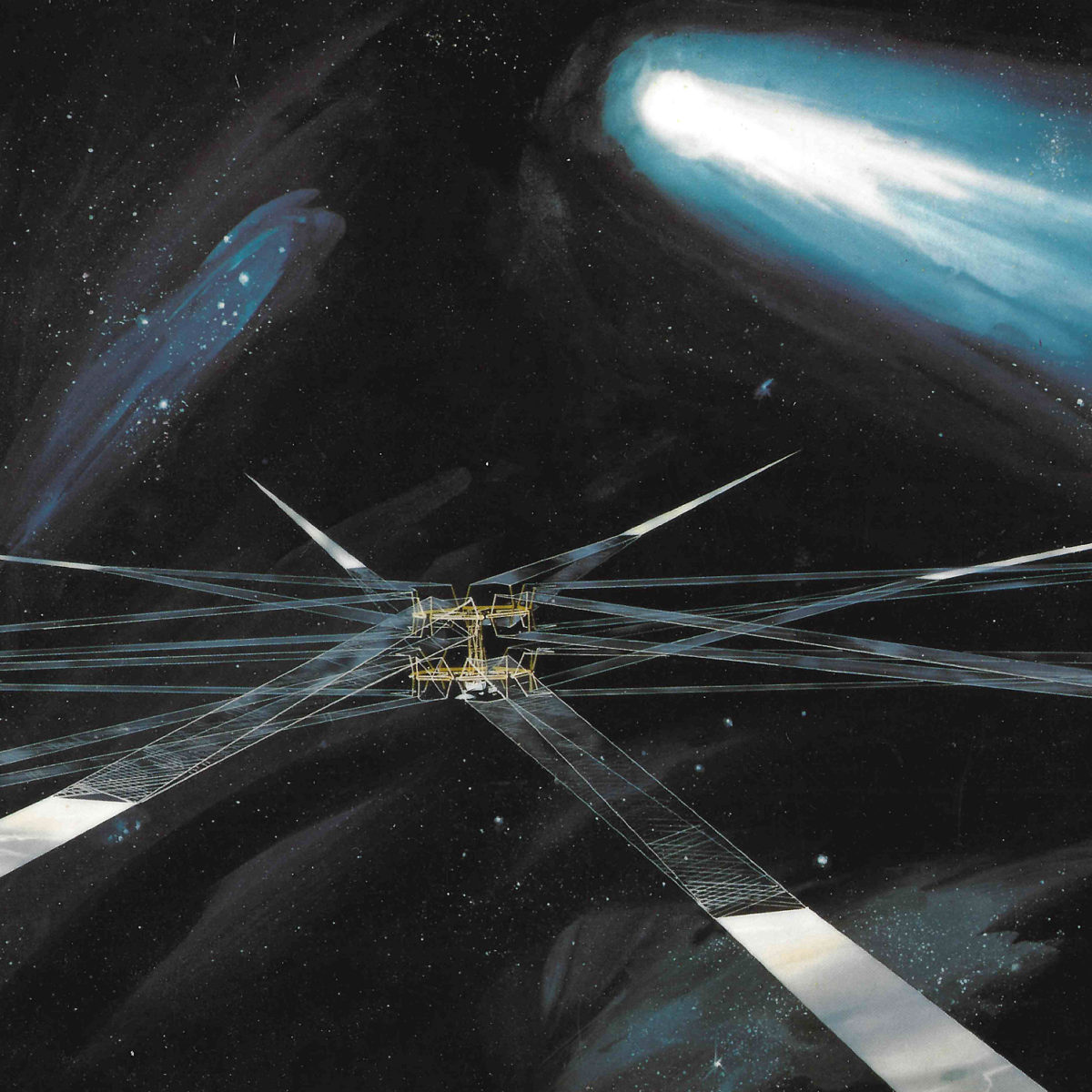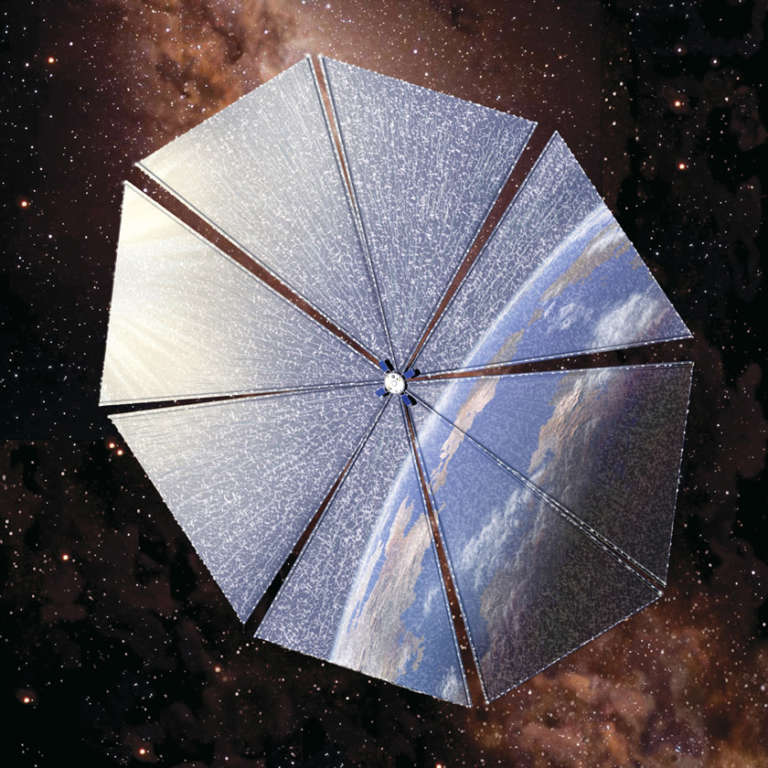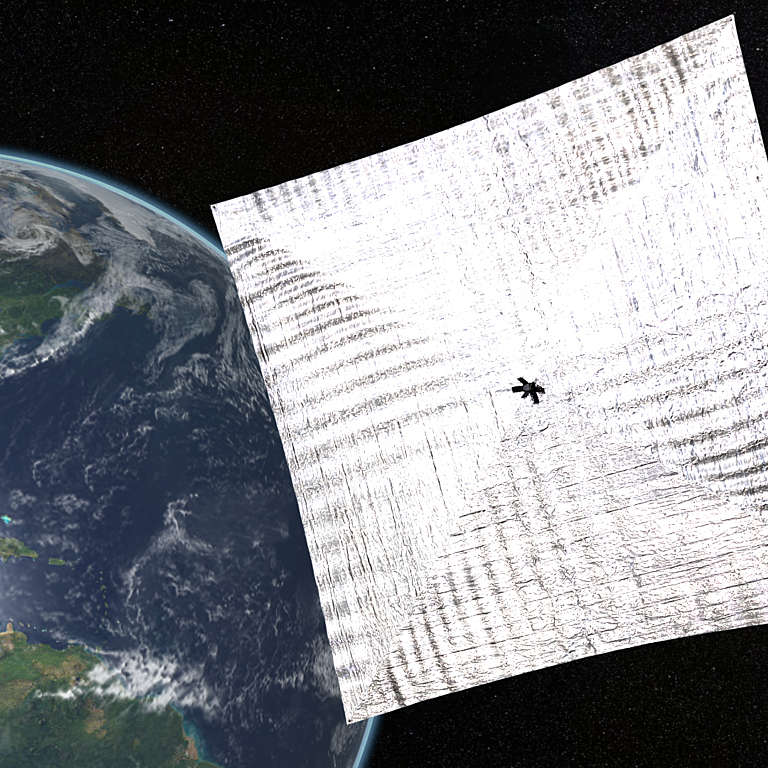LightSail, a Planetary Society solar sail spacecraft
Highlights
- The Planetary Society's LightSail program demonstrated that solar sailing is a viable means of propulsion for small satellites.
- Solar sails use sunlight instead of rocket fuel for propulsion. They are one of the few technologies that could be used for interstellar travel.
- Our LightSail 2 spacecraft was in space from June 2019 to November 2022 and successfully used sunlight alone to change its orbit around Earth.
LightSail® is a crowdfunded project from The Planetary Society to demonstrate that solar sailing is a viable means of propulsion for CubeSats — small, standardized spacecraft that are part of a global effort to lower the cost of space exploration. Our LightSail 2 spacecraft, which launched on June 25, 2019 and reentered Earth's atmosphere on Nov. 17, 2022, used sunlight alone to change its orbit.
LightSail 2 completes mission with atmospheric reentry
The three-and-a-half-year solar sailing mission showed LightSail 2 could change its orbit with sunlight alone.
LightSail 2 was named one of TIME’s 100 Best Inventions of 2019, and won a Popular Science Best of What’s New award for 2019. The spacecraft carried a disk with names, selfies, and other messages from our members and supporters. Search for your participation certificate here.
LightSail 2's views of Earth A compilation of images taken by The Planetary Society's LightSail 2 spacecraft from orbit. It shows the solar sails' deployment as well as many views of Earth.Video: The Planetary Society
What is solar sailing?
A solar sail, simply put, is a spacecraft propelled by sunlight. Whereas conventional rockets are propelled by the combustion of rocket fuel, a solar sail is pushed forward by light from the Sun. Learn more about the basics of flight by light here.
Light is made of packets of energy called photons. While photons have no mass, they have momentum. Solar sails capture this momentum with sheets of large, reflective material such as Mylar. As photons bounce off the sail, most of their momentum is transferred, speeding up the sail in the direction opposite the bouncing light.
Unlike chemical rockets that provide short, powerful bursts of thrust, solar sails provide continuous, slight thrust and can reach higher speeds over time. Sunlight is free and unlimited, whereas rocket propellant must be carried into orbit and be stored onboard a spacecraft.
Solar sails are also one of the only known methods that could someday be used to travel to the stars. In 2016, the group Breakthrough Initiatives announced an initiative to send a fleet of laser-powered solar sails to our nearest star, Alpha Centauri.
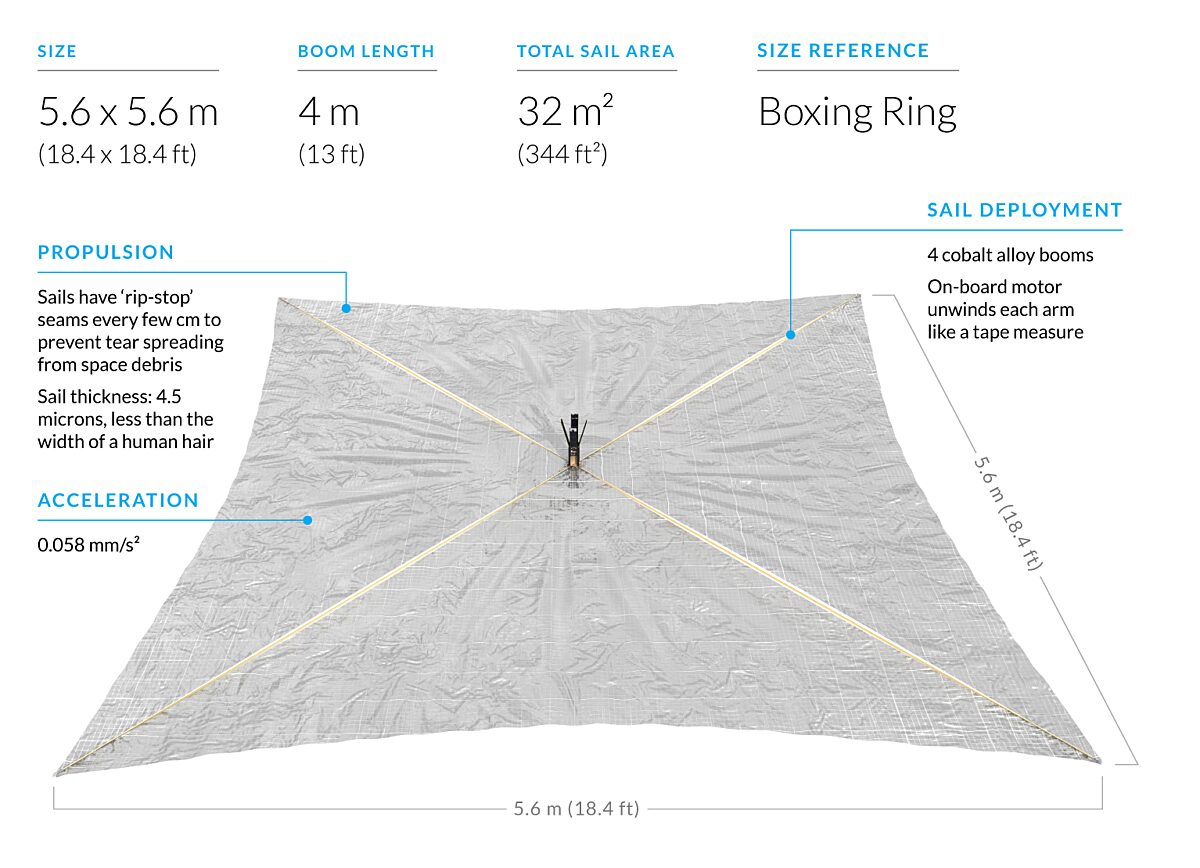
When did LightSail 2 launch?
LightSail 2 launched on June 25, 2019. The spacecraft was enclosed within Prox-1, a Georgia Tech student-built spacecraft the size of a large suitcase that was selected to fly as part of the Air Force’s University Nanosat Program. Both spacecraft were attached to the upper stage of SpaceX's Falcon Heavy rocket, which launched 24 spacecraft to orbit for the U.S. Air Force’s Space Test Program 2 (STP-2) mission. Prox-1 and LightSail 2 were delivered into a circular, 720-kilometer (447-mile) orbit with an inclination of 24 degrees.
Seven days after launch, Prox-1 ejected LightSail 2. After a checkout period of a few days, LightSail 2 opened its hinged solar arrays. On July 23, 2019, it deployed its 32-square-meter solar sails. Each orbit, LightSail 2 swings its solar sail into and away from the Sun's rays, giving the spacecraft a slight push.
When did LightSail 2 come down?
The Planetary Society’s LightSail 2 spacecraft reentered Earth’s atmosphere on Nov. 17, 2022, successfully completing its mission to demonstrate flight by light for small spacecraft.
Though the spacecraft orbited Earth higher than the
International Space Station, the planet’s atmosphere was thick
enough to counteract the thrust gained from solar sailing. Analyses of
orbital data showed that LightSail 2’s rate of orbital decay was markedly
slower in solar sailing mode, when the craft actively positioned itself
to get a push from sunlight. During some time intervals, the spacecraft
even gained enough thrust to briefly overcome atmospheric drag and raise
its orbit. However, atmospheric drag eventually won out, bringing the spacecraft down low enough that it burned up.
LightSail 2 images from space
LightSail 2 regularly transmitted images from its onboard cameras.
These images helped engineers track the condition of the sail while
providing stunning public outreach images. See the full collection of images from the spacecraft here.

How LightSail enabled future solar sail missions
LightSail 2 was meant to enable and support future solar sailing missions. A big part of our extended mission involved sharing what we were learning. We published peer-reviewed journal articles, made conference presentations and conducted public outreach through social media and articles like the one you’re reading right now.
We also interfaced directly with other solar sailing missions. NASA has three such missions planned or underway: NEA Scout, Solar Cruiser, and ACS3. We continue share data and facilitate additional studies to help these mission teams learn from our experiences. Furthermore, we document and archive our LightSail 2 data so that it is available for analysis by future missions.
Project history
The Planetary Society's history with solar sailing dates back to the mid-1970s, when co-founder Louis Friedman led a NASA effort to send a solar sail spacecraft to visit Halley’s Comet. Fellow co-founder Carl Sagan promoted the concept on The Tonight Show with Johnny Carson in 1976.
The Planetary Society’s first crowdfunded solar sail mission, Cosmos 1, failed to reach orbit after launching aboard a Russian rocket in 2005.
Japan’s IKAROS spacecraft, launched to interplanetary space with Venus-bound Akatsuki in 2010, was the first spacecraft to use controlled solar sailing its a sole method of propulsion.
LightSail, which began development in 2009, demonstrated the technology for CubeSats. CubeSats have revolutionized the space industry thanks to low-cost technology miniaturization, but often lack a means of propulsion. Weighing 60 times less than IKAROS but sporting a sail just 6 times smaller, LightSail demonstrated that CubeSats can carry solar sails with enough punch for orbital maneuvers, and still have room for science instruments.
LightSail 1, identical to LightSail 2 with a few key differences, completed a successful deployment test in 2015. LightSail 2 launched in 2019.
The Story of LightSail, Part 1
The first installment of our three-part LightSail history series looks back at the origins of solar sailing and a NASA project to send a giant solar sail to Halley's Comet.
The Story of LightSail, Part 2
The second entry in our three-part LightSail history series remembers Cosmos 1, The Planetary Society's first solar sail that launched in 2005 aboard an ill-fated Russian rocket.
The Story of LightSail, Part 3
The final chapter of our three-part LightSail history series details how the loss of Cosmos 1 gives rise to the dream of solar sailing for CubeSats.
Funding and Partners
The LightSail project cost was $7 million from 2009 through March 2019. Funding was provided by Planetary Society members, private citizens, foundations, and corporate partners. A Kickstarter campaign raised $1.24 million in 2015, while two Omaze fundraisers in 2017 and 2018 generated more than $220,000.
Spacecraft design and construction: Stellar Exploration, Inc.
Lead contractor for integration and testing: Ecliptic Enterprises Corporation
LightSail testing facilities and mission control: Cal Poly San Luis Obispo
Ground stations: Cal Poly San Luis Obispo, Georgia Tech, Purdue University, Kauai Community College
Contractors: Boreal Space, Georgia Tech, Purdue, Aquila Space, NXTRAC
Additional support: Air Force Research Laboratory, UCLA, Utah State
LightSail 1 launch provided by NASA’s Educational Launch of Nanosatellites program
LightSail 2 launch provided by University Nanosat Program, Air Force Research Laboratory
Program manager: Bruce Betts, The Planetary Society
Project manager and mission manager: Dave Spencer, Purdue University
Support projects like LightSail
Whether it's advocating, teaching, inspiring, or learning, you can do something for space, right now. Let's get to work.


 Explore Worlds
Explore Worlds Find Life
Find Life Defend Earth
Defend Earth




